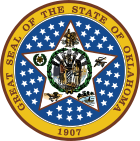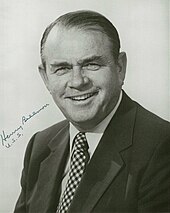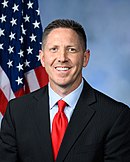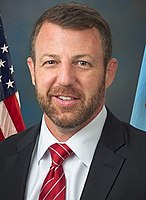Oklahoma Republican Party
 From Wikipedia - Reading time: 15 min
From Wikipedia - Reading time: 15 min
Oklahoma Republican Party | |
|---|---|
 | |
| Chairperson | Nathan Dahm |
| President pro tempore of the Senate | Greg Treat |
| Speaker of the House | Charles McCall |
| Founded | 1907 |
| Headquarters | Dewey F. Barlett Center 4031 N. Lincoln Blvd Oklahoma City 73105 |
| Membership (2023) | |
| Ideology | Conservatism |
| National affiliation | Republican Party |
| Unofficial colors | Red |
| Statewide Executive Offices | 12 / 12
|
| Seats in the United States Senate | 2 / 2
|
| Seats in the United States House of Representatives | 5 / 5
|
| Seats in the Oklahoma Senate | 40 / 48
|
| Seats in the Oklahoma House of Representatives | 81 / 101
|
| Tribal Chiefs | 3 / 5
|
| Website | |
| www | |
 |
|---|
The Oklahoma Republican Party is an Oklahoma political party affiliated with the Republican Party. Along with the Oklahoma Democratic Party, it is one of the two major parties in the state.
It is currently the dominant party in the state, controlling all five of Oklahoma's U.S. House seats, both U.S. Senate seats, the governorship, and has supermajorities in both houses of the state legislature.
Current structure and composition
[edit]The Oklahoma Republican Party headquarters is located on North Lincoln Boulevard in Oklahoma City.[2] Additionally, the state party has a Tulsa office on East 51st Street.[2] They host the biennial state conventions in odd-numbered years, in which they elect executive officers and delegates to the Republican National Committee.[2]
The state party coordinates campaign activities with Republican candidates and county parties and receives some funding from the national GOP organizations.
History
[edit]Territorial period through 1930s
[edit]The Oklahoma Republican Party takes its roots from the territorial period, gaining a larger portion of its support from the Northwestern part of the state, where migrants from the state of Kansas brought with them Republican political leanings of the time.[3] For most of Oklahoma history, the Oklahoma Republican Party has the fewest members in the old Indian Territory or the area located in the Southeast.[3]
Republicans held the American presidency during most of the territorial period, resulting in the appointments of Republican territorial governors. Despite the dominance of Republicans as governor and delegate, the two main parties had almost reached parity in the territorial legislature by statehood.[4]
The Republican Party at the time of statehood in 1907 was not the party of most Oklahomans, but was the party of most African-Americans. Republican A. C. Hamlin was Oklahoma's first black legislator, serving in the first legislature of the new state.[5]
Republicans experienced a short-lived resurgence in the early 1920s, with the election of John W. Harreld in 1920 as the first Republican United States senator for the state of Oklahoma. During this time the Republican Party had gained a majority of the state's seats in United States Congress, attaining five of the nine seats available. The Oklahoma House of Representatives saw their first Republican majority and first Republican Speaker of the Oklahoma House of Representatives from 1921 to 1923.[6] The first female member of the Oklahoma House of Representatives was a Republican.[7] Also, the first woman to preside over the House of Representatives, Alice Robertson, was from Oklahoma.
In the 1928 election, Republicans gained 26 new seats in the Oklahoma House of Representatives due in part to the low popularity of the time of presidential candidate Al Smith and the incumbent governor's stumping on his behalf.[8] With a total of forty-seven seats, they were only five seats from having a majority.[8] With thirteen Democratic members, they elected a coalition Democratic Speaker over the incumbent speaker.[8]
But it was the 1930s or The Great Depression that would prove to be the most troublesome for Republicans in Oklahoma. It was during this time that Republican voters had shifted their support to the revitalized Democratic Party.[3]
Late 20th century
[edit]
Beginning in the 1960s, the Oklahoma Republican party made gains in voter registration and state legislative seats.[9] Henry Bellmon won election as Oklahoma's first Republican governor in 1962, by appealing to Democratic voters and as an anti-corruption candidate.[10] Only 18 percent of Oklahomans were registered as Republicans at the time.[9]
Bellmon's term helped increase the image of Republicans in Oklahoma. Under his administration, total highway projects increased 46 percent over the previous administration and the first retirement system for state employees was created.[10] Bellmon also oversaw the racial integration of Oklahoma schools and the court-ordered reapportionment of the state electoral districts.
Bellmon won election to the United States Senate in 1968.[10] Republican Don Nickles succeeded Bellmon in 1980.
In 1990, black Republican J.C. Watts was elected as Oklahoma's first black statewide officeholder, serving on the Oklahoma Corporation Commission,[11] serving as a member of the commission from 1990 to 1995 and as chairman from 1993 to 1995.
21st century
[edit]2000s
[edit]After the 2004 Presidential Election, Republicans gained control of the Oklahoma House of Representatives for the first time since 1921.[12]
2010s
[edit]In 2010, Republicans increased their gains in the Oklahoma House of Representatives and took majority control of the Oklahoma Senate.[13] Furthermore, Republicans captured every statewide office and came within six percentage points of capturing the 2nd District (the only Congressional seat that it did not already hold); in 2012 it would capture that seat as well and gain supermajority control of both chambers of the Oklahoma Legislature.
In 2015, the number of registered Republican voters overtook the number of registered Democratic voters for the first time in the state's history (as of January 15, 2015, there are 886,153 registered Republicans, 882,686 registered Democrats, and 261,429 independent voters).[14]
2020s
[edit]After Joe Biden won the 2020 election and Donald Trump refused to concede while making false claims of fraud, Oklahoma Republican Party head John R. Bennett said he would support a primary challenge against incumbent Oklahoma Senator James Lankford because Lankford refused to object to the certification of the Electoral College results in Congress.[15]
On July 27, 2021, the Jewish Federation of Tulsa and Greater Oklahoma City denounced the Oklahoma Republican Party's use of the yellow Star of David in a Facebook post by the party. The picture included a yellow Star of David with the words "Unvaccinated" accompanied by numbers meant to be reminiscent of the numbers tattooed on victims of the Holocaust. The post called on party members to call Lieutenant Governor of Oklahoma, who was acting Governor of Oklahoma at the time, to call a special legislative session to pass legislation banning vaccine mandates. The post was denounced by many high-ranking members of the Oklahoma Republican Party including Governor Kevin Stitt, Lt. Governor Matt Pinnell, U.S. Senators James Lankford & Jim Inhofe, U.S. Congressman Markwayne Mullin, and both the Oklahoma Legislature's leaders Greg Treat and Charles McCall.[16] The post was also denounced in separate statements by Oklahoma Superintendent of Public Instruction Joy Hofmeister and Oklahoma Republican Party Vice Chair Shane Jemison.[17] The American Jewish Committee and the Jewish Federation also denounced the Facebook post.[18][19] On August 1, 2021, Oklahoma Republican Party Chairman John Bennett defended his comments, saying “When they put that on the Jews, they weren’t sending them directly to the gas chambers, they weren’t sending them directly to the incineraries. This came before that," and “It’s not about the star. It’s about a totalitarian government.”[19] The same day The Norman Transcript reported a majority of Republicans are unhappy with Bennett and that plans were in the works to remove him from office. Removal of a sitting chair of the Oklahoma Republican Party requires either the vice-chair or one of the other two national committee members to call for a vote for removal. After the vote, a 10-day notice is given before the state committee votes on the removal.[20] Some Republican groups supported Bennett including the Oklahoma Second Amendment Association President Don Spencer and Tulsa County Republican Chairwoman Ronda Vuillemont-Smith.[21]
Electoral history
[edit]| Election year | No. of House seats |
+/– | Governorship | No. of Senate seats |
+/– |
|---|---|---|---|---|---|
| 1907 | 16 / 101
|
Charles N. Haskell | 6 / 48
|
||
| 1908 | 39 / 101
|
10 / 48
|
|||
| 1910 | 26 / 101
|
Lee Cruce | 13 / 48
|
||
| 1912 | 19 / 101
|
10 / 48
|
|||
| 1914 | 18 / 101
|
Robert L. Williams | 6 / 48
|
||
| 1916 | 26 / 101
|
5 / 48
|
|||
| 1918 | 30 / 101
|
James B.A. Robertson | 10 / 48
|
||
| 1920 | 73 / 101
|
17 / 48
|
|||
| 1922 | 14 / 101
|
Jack C. Walton | 12 / 48
|
||
| 1924 | 24 / 101
|
Martin Trapp | 6 / 48
|
||
| 1926 | 22 / 101
|
Henry S. Johnston | 9 / 48
|
||
| 1928 | 47 / 101
|
10 / 48
|
|||
| 1930 | 10 / 101
|
William H. Murray | 12 / 48
|
||
| 1932 | 4 / 101
|
5 / 48
|
|||
| 1934 | 7 / 101
|
E.W. Marland | 1 / 48
|
||
| 1936 | 3 / 101
|
0 / 48
|
|||
| 1938 | 13 / 101
|
Leon C. Phillips | 1 / 48
|
||
| 1940 | 7 / 101
|
2 / 48
|
|||
| 1942 | 24 / 101
|
Robert S. Kerr | 4 / 48
|
||
| 1944 | 22 / 101
|
6 / 48
|
|||
| 1946 | 22 / 101
|
Roy J. Turner | 6 / 48
|
||
| 1948 | 12 / 101
|
5 / 48
|
|||
| 1950 | 20 / 101
|
Johnston Murray | 4 / 48
|
||
| 1952 | 13 / 101
|
6 / 48
|
|||
| 1954 | 19 / 101
|
Raymond D. Gary | 5 / 48
|
||
| 1956 | 20 / 101
|
3 / 48
|
|||
| 1958 | 10 / 101
|
J. Howard Edmondson | 3 / 48
|
||
| 1960 | 13 / 101
|
4 / 48
|
|||
| 1962 | 24 / 101
|
Henry Bellmon | 6 / 48
|
||
| 1964 | 22 / 101
|
7 / 48
|
|||
| 1966 | 23 / 101
|
Dewey F. Bartlett | 9 / 48
|
||
| 1968 | 22 / 101
|
10 / 48
|
|||
| 1970 | 22 / 101
|
David Hall | 9 / 48
|
||
| 1972 | 23 / 101
|
10 / 48
|
|||
| 1974 | 23 / 101
|
David L. Boren | 10 / 48
|
||
| 1976 | 20 / 101
|
10 / 48
|
|||
| 1978 | 24 / 101
|
George Nigh | 11 / 48
|
||
| 1980 | 26 / 101
|
12 / 48
|
|||
| 1982 | 26 / 101
|
14 / 48
|
|||
| 1984 | 32 / 101
|
14 / 48
|
|||
| 1986 | 31 / 101
|
Henry Bellmon | 17 / 48
|
||
| 1988 | 32 / 101
|
14 / 48
|
|||
| 1990 | 34 / 101
|
David Walters | 12 / 48
|
||
| 1992 | 34 / 101
|
13 / 48
|
|||
| 1994 | 41 / 101
|
Frank Keating | 17 / 48
|
||
| 1996 | 42 / 101
|
19 / 48
|
|||
| 1998 | 42 / 101
|
19 / 48
|
|||
| 2000 | 48 / 101
|
21 / 48
|
|||
| 2002 | 47 / 101
|
Brad Henry | 22 / 48
|
||
| 2004 | 46 / 101
|
22 / 48
|
|||
| 2006 | 57 / 101
|
24 / 48
|
|||
| 2008 | 61 / 101
|
26 / 48
|
|||
| 2010 | 70 / 101
|
Mary Fallin | 32 / 48
|
||
| 2012 | 72 / 101
|
36 / 48
|
|||
| 2014 | 72 / 101
|
40 / 48
|
|||
| 2016 | 75 / 101
|
40 / 48
|
|||
| 2018 | 76 / 101
|
Kevin Stitt | 39 / 48
|
||
| 2020 | 81 / 101
|
39 / 48
|
|||
| 2022 | 80 / 101
|
40 / 48
|
Note: Lieutenant Governor Jari Askins provided tie breaking vote in the State Senate following the 2006 elections, giving Democrats a majority
Notable Oklahoma Republicans
[edit]

- Dewey F. Bartlett, Oklahoma's first Roman Catholic governor
- Gary Batton, Choctaw chief
- Susan Bayro, first Osage mayor of Pawhuska
- Henry Bellmon, Oklahoma's first Republican governor
- Lisa Johnson Billy, Speaker of the Chickasaw Tribal Legislature
- David Ross Boyd, first President of the University of Oklahoma
- Tom Coburn, physician in Family Medicine and U.S. Senator
- Gilbert Dukes, Choctaw chief who lost the 1910 lieutenant governor's election to J. J. McAlester
- Mary Fallin, Oklahoma's first female governor
- A. C. Hamlin, Oklahoma's first black state legislator after statehood
- John W. Harreld, Oklahoma's first Republican U.S. Senator
- Shane Jett, chairman of the U.S. Treasury CDFI Fund Community Development Advisory Board.
- Edward P. McCabe, founder of Langston, leading figure to stimulate black migration into the Oklahoma Territory
- Bessie S. McColgin, one of Oklahoma's first female state legislators
- Green McCurtain, last elected chief of the Choctaws before Oklahoma statehood
- Don Nickles, youngest Republican ever elected to the U.S. Senate
- Oral Roberts, Christian Evangelist
- Alice Mary Robertson, the first woman to defeat an incumbent congressman, second to be elected to the U.S. House
- George B. Schwabe, first Republican Speaker of the Oklahoma House of Representatives
- T.W. Shannon, Oklahoma's first black Speaker of the Oklahoma House of Representatives
- Ross Swimmer, Cherokee chief
- J.C. Watts, Oklahoma's first black U.S. Representative
- Bud Wilkinson, legendary University of Oklahoma football coach who lost the 1964 U.S. Senate election to Fred R. Harris
- Muriel Hazel Wright, Historian, author, editor of the Chronicles of Oklahoma
Current elected officials
[edit]As of 2023, the Oklahoma Republican Party controls all 12 statewide executive offices and holds majorities in both the Oklahoma Senate and the Oklahoma House of Representatives; Republicans also hold both of the state's U.S. Senate seats and all five of the state's U.S. House seats.[22]
Members of Congress
[edit]U.S. Senate
[edit]-
Senior U.S. Senator James Lankford
-
Junior U.S. Senator Markwayne Mullin
U.S. House of Representatives
[edit]| District | Member | Photo |
|---|---|---|
| 1st | Kevin Hern |  |
| 2nd | Josh Brecheen |  |
| 3rd | Frank Lucas |  |
| 4th | Tom Cole |  |
| 5th | Stephanie Bice |  |
State Officials
[edit]Statewide offices
[edit]- Governor: Kevin Stitt[22]
- Lieutenant Governor: Matt Pinnell[22]
- Secretary of State: Josh Cockroft
- State Auditor and Inspector: Cindy Byrd[22]
- Attorney General: Gentner Drummond[22]
- Treasurer: Todd Russ[22]
- Superintendent of Public Instruction: Ryan Walters
- Labor Commissioner: Leslie Osborn[22]
- Insurance Commissioner: Glen Mulready[22]
- Corporation Commissioners: Bob Anthony, Todd Hiett and Kim David[22]
Legislative leadership
[edit]- President Pro Tem of the Senate: Greg Treat
- Senate Majority Floor Leader: Greg McCortney
- Speaker of the House: Charles McCall
- House Majority Floor Leader: Josh West
City officials
[edit]Republican Governors
[edit]As of 2019[update], there have been a total of six Republican Party Governors.
| # | Name | Picture | Lifespan | Gubernatorial start date |
Gubernatorial end date |
|---|---|---|---|---|---|
| 18 | Henry Bellmon | 
|
1921–2009 | January 14, 1963 | January 9, 1967 |
| 19 | Dewey F. Bartlett | 
|
1919–1979 | January 9, 1967 | January 11, 1971 |
| 23 | Henry Bellmon | 
|
1921–2009 | January 12, 1987 | January 14, 1991 |
| 25 | Frank Keating | 
|
1944– | January 9, 1995 | January 13, 2003 |
| 27 | Mary Fallin | 
|
1954– | January 10, 2011 | January 14, 2019 |
| 28 | Kevin Stitt | 
|
1972– | January 14, 2019 |
Electoral history
[edit]Gubernatorial
[edit]| Election | Gubernatorial candidate | Votes | Vote % | Result |
|---|---|---|---|---|
| 1994 | Frank Keating | 466,740 | 46.9% | Won |
| 1998 | Frank Keating | 505,498 | 57.9% | Won |
| 2002 | Steve Largent | 441,277 | 42.6% | Lost |
| 2006 | Ernest Istook | 310,327 | 33.50% | Lost |
| 2010 | Mary Fallin | 625,506 | 60.45% | Won |
| 2014 | Mary Fallin | 460,298 | 55.80% | Won |
| 2018 | Kevin Stitt | 644,579 | 54.33% | Won |
| 2022 | Kevin Stitt | 639,484 | 55.45% | Won |
See also
[edit]- Oklahoma
- Oklahoma Democratic Party
- Oklahoma Libertarian Party
- Oklahoma's congressional districts
- Politics of Oklahoma
- Republican Party
References
[edit]- ^ "Voter Registration Statistics" (PDF). Oklahoma State Election Board. Retrieved 2 August 2023.
- ^ a b c Oklahoma Republican Party (accessed May 11, 2013).
- ^ a b c Gaddie, Ronald. REPUBLICAN PARTY Archived 2011-09-03 at the Wayback Machine, Encyclopedia of Oklahoma History and Culture, Oklahoma Historical Society (accessed May 11, 2013)
- ^ Brown, Kenny. OKLAHOMA TERRITORY Archived 2011-11-14 at the Wayback Machine, Encyclopedia of Oklahoma History and Culture] (accessed May 11, 2013)
- ^ Bruce, Mic hael. HAMLIN, ALBERT COMSTOCK (1881-1912), Encyclopedia of Oklahoma History and Culture (accessed May 11, 2013)
- ^ Hannemann, Carolyn G. SCHWABE, GEORGE BLAINE Archived 2012-11-19 at the Wayback Machine, Encyclopedia of Oklahoma History and Culture (accessed May 11, 2013)
- ^ Pappas, Christine. MCCOLGIN AMELIA ELIZABETH SIMISON Archived 2014-12-07 at the Wayback Machine, Encyclopedia of Oklahoma History and Culture (accessed May 11, 2013)
- ^ a b c A Century to Remember Archived 2012-09-10 at the Wayback Machine (accessed May 11, 2013)
- ^ a b Gaddie, Ronald Keith. Democratic Party, Encyclopedia of Oklahoma History and Culture (accessed May 11, 2013)
- ^ a b c Hannemann, Carolyn G. BELLMON, HENRY LOUIS Archived 2009-01-05 at the Wayback Machine, Encyclopedia of Oklahoma History and Culture (accessed May 11, 2013)
- ^ Verhovek, Sam Howe (1994-10-07). "The 1994 Campaign: The Republicans; More Black Candidates Find Places on Republican Ballots". The New York Times. Retrieved 2013-05-11.
- ^ McNutt, Michael. "Republicans select speaker designate" http://newsok.com/republicans-select-speaker-designate/article/2969390, The Oklahoman November 10, 2006.
- ^ McNutt, Michael. "Oklahoma's legislative leaders pledge to work with Democrats", The Oklahoman, November 7, 2010.
- ^ "January 2015 Month End Registration Statistics by County" (PDF). Oklahoma State Elections Board. January 31, 2015.
- ^ World, Blake Douglas Tulsa (6 July 2021). "Sen. Lankford responds to 'unheard of' lack of neutrality from state GOP chairman". Tulsa World. Retrieved 2021-07-06.
- ^ Hoberock, Barbara (31 July 2021). "Jewish Federation of Tulsa calls out state GOP for using Star of David in vaccine dispute". Tulsa World. Retrieved 1 August 2021.
- ^ Forman, Carmer (31 July 2021). "Top Republicans denounce Oklahoma GOP for comparing vaccine mandates to Jewish persecution". The Oklahoman. Retrieved 1 August 2021.
- ^ "Statement". twitter.com. American Jewish Committee. Retrieved 1 August 2021.
- ^ a b KOCO Staff (1 August 2021). "Oklahoma GOP chairman doubles down on social media post comparing vaccine mandates to the Holocaust". KOCO 5 News ABC. Retrieved 1 August 2021.
- ^ Gorman, Reese (1 August 2021). "SOURCES: Talks underway to potentially remove Bennett as chair". The Norman Transcript. Retrieved 1 August 2021.
- ^ Forman, Carmen (8 August 2021). "Holocaust comparison from GOP chairman John Bennett deepens divisions among Oklahoma Republicans". The Oklahoman. Retrieved 8 August 2021.
- ^ a b c d e f g h i j k Oklahoma Republican Partry. "Elected Officials". Retrieved May 11, 2013.
External links
[edit]- Oklahoma Republican Party Home Page
- Oklahoma Federation of College Republicans
- Oklahoma Republican Party Grassroots Platform 2005
- Current Oklahoma Republican Elected Officials.
- Oklahoma Historical Society page listing Oklahoma Governors.
- Lawton Politics
- Voices of Oklahoma interview with Henry Bellmon. First person interview conducted on April 14, 2009, with Henry Bellmon. Original audio and transcript archived with Voices of Oklahoma oral history project.
 KSF
KSF
